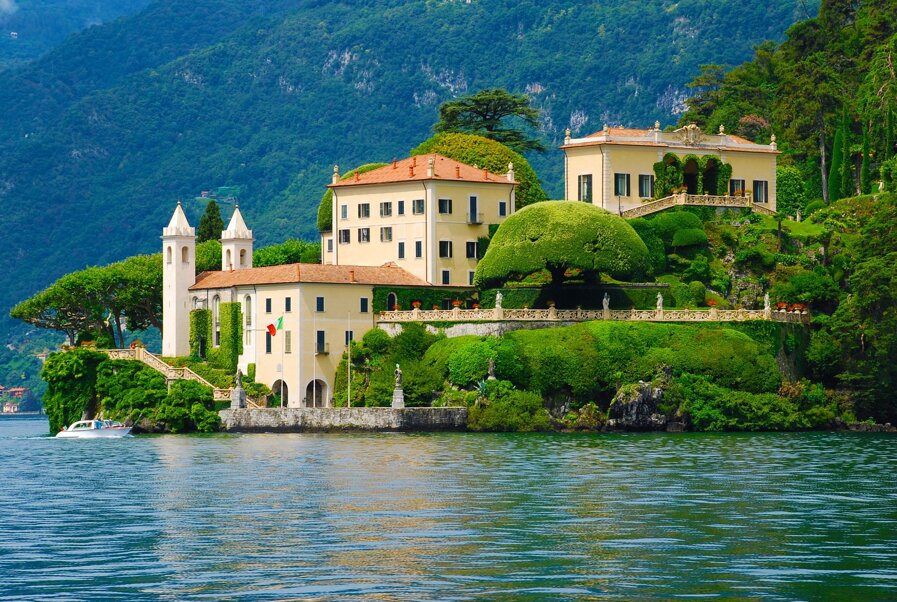Larihome by Casartelli Francesco
Privacy - Cookie policy
Villa Balbianello
Villa Balbianello

The Balbianello complex is one of the most harmonious examples of a villa-garden, whose charm, even more than from this or that detail, emanates from the environment as a whole, especially when observed from the lake.
Built on a promontory of Lake Como, the Dosso di Lavedo, the villa has origins dating back to the eighteenth century, the century that saw the explosion of the sociocultural phenomenon of the so-called villas of delight. The genius loci in this case was the Milanese cardinal Angelo M. Durini, who, after spending long periods as a papal nuncio abroad, decided to spend his last years in one of the most pleasant places in Lombardy, between the lake of Diana (the Gulf of Campo) and the lake of Venus (Lenno).
The prelate, although already owning Villa del Balbiano, demanded a more rugged and almost isolated site, where he could receive frivolous characters, but also philosophers and men of letters, such as Abbot Parini who dedicated the ode La Gratitudine to him.
The place was also loved and enhanced by subsequent owners, the Porro Lambertenghi, the Arconati Visconti, and the famous explorer Guido Monzino, who decorated the villa with furniture and works of art collected during his travels. He was in fact the first Italian to reach the summit of Everest in 1973, and just a couple of years earlier he took part in an expedition that led him to the North Pole.
In 1988 he donated the villa to the Fondo per l'Ambiente Italiano, adding to his will a clause regarding the wish to have the large oak pruned every year that stands in front of the window of the room he used as a study to plan his expeditions.
If the house played an important role, no less was that of the garden, which moreover could not adhere to the principles of post-Baroque formality, because the natural environment would not have allowed it. Therefore, a landscape design prevailed, which is still adopted and meticulously perfected today.
The arboreal heritage is impressive (holm oaks, plane trees, magnolias, cypresses, pines, and beeches), some of which are pruned in topiary art. There is no lack of fragrant plants (wisteria and Osmanthus), as well as the praised climbing Ficus pumila, which covers the entire portico, where Durini is said to have loved to sip his coffee.
The Balbianello complex is one of the most harmonious examples of the villa and garden, whose fascination derives from the overall effect rather than any particular detail.
Situated on Dosso di Lavedo, one of the few promontories on Lake Como, the villa dates to the 18th century, the period that saw the explosion of the sociocultural phenomenon known as the “pleasure-house”. In this case, the genius loci was the Milanese cardinal Angelo M. Durini who, after spending long periods abroad as papal nuncio, decided to spend his last years in one of the most pleasant places in Lombardy, with the Lake of Diana (Gulf of Campo) on one side and the Lake of Venus (Lenno) on the other.
Although he already owned Villa del Balbiano, the prelate wanted an almost isolated site, where he could receive frivolous personages, but also philosophers and men of letters like Abbot Parini, who dedicated an ode entitled Gratitude to him.
The place was enhanced also by its subsequent owners the Porro Lambertenghi and Arconati Visconti families, and the explorer Guido Monzino who decorated the villa with furniture and works of art collected during his travels.
He was in fact the first Italian man that reached the summit of Everest in 1973, and just a couple of years earlier he took part in an expedition that took him to the North Pole. In 1988 he donated the villa to the F.A.I, adding to his will a clause concerning the desire to prune every year the large oak that stands in front of the window of the room that he used as a study to plan his expeditions.
The garden’s role was as important as that of the house, but it could not adhere to formal post-Baroque principles because the natural setting was unsuitable for this.
A landscape layout was adopted, which is still maintained today. The arboreal heritage is impressive ilex, plane, magnolia, cypress, pine, beech trees, some of which sculpted in topiary. There is no lack of scented plants (Wisteria and Osmanthus) and everyone admires the Ficus pumila in the portico beneath which it is said that Durini liked to sit and sip his coffee.
Info: www.fondoambiente.it
Villa del Balbianello (FAI)
Via Comoedia 5 22016 Lenno FAI - Fondo per the Italian Environment Fund
Tel. 0344 56110
Email faibalbianello@ fondoambiente.it
Taken from “I GIRADINI”, Grandi Giardini Italiani (www.grandigiardini.it) – CCIAA Como, Province of Como. The entire guide can be consulted at http://www.co.camcom.it/guideturismo
Subscribe to our newsletter to stay updated on all the news and receive the best tips on places to visit on Lake Como!
Larihome by Casartelli Francesco
Privacy - Cookie policy